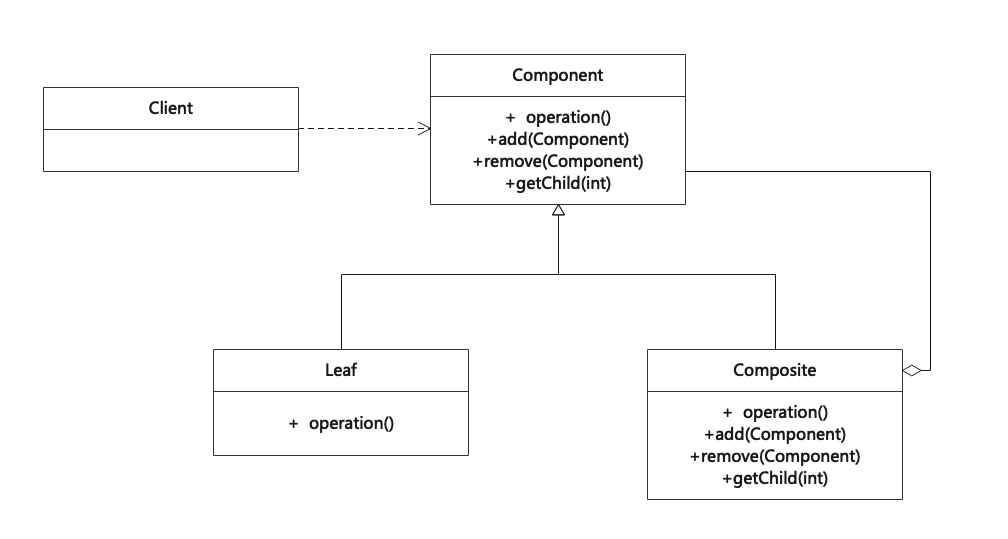组合模式是一种结构型设计模式,主要用来将多个对象组织成树形结构以表示“部分-整体”的层次结构,因此该模式也称为“部分-整体”模式。简言之,组合模式就是用来将一组对象组合成树状结构,并且能像使用独立对象一样使用它们。
Composite is a structural design pattern that lets you organize multiple objects into a tree structure to represent the "part whole" relationship. In short, the composite pattern can be used to combine a group of objects into a tree structure and use them as independent objects.
结构设计
为实现组合模式,首先需要创建一个可以组合多个对象的单一对象(Component),这个对象用来访问和管理其子对象,并对外提供公共接口。然后,定义没有子节点的对象(Leaf,基本对象)和包含子对象的对象(Composite,组合对象)。最后,将这些对象组装到之前创建的对象上。这样,外部(Client)就可通过Component调用公共接口。组合模式包含如下角色:
Component,组合对象,为组合中的对象声明公共接口,并提供默认实现。
Leaf,叶节点对象,叶节点最终会完成大部分的实际工作,因为它们无法将工作指派给其他部分。
Compoiste,组合,也称容器,包含叶节点或其他容器的单位。容器不知道其子项目所属的具体类, 它只通过通用的组件接口与其子项目交互。
组合模式类图表示如下:

注意:
(1) 组合模式对基本对象和组合对象的使用具有一致性。外部代码调用Component公共接口时,无需区别对待基本对象和组合对象(透明性),大多数情况下可以一致地处理它们。
伪代码实现
接下来将使用代码介绍下组合模式的实现。
// 1、Component,组合对象,为组合中的对象声明公共接口,并提供默认实现。
public abstract class Component {private String name;protected List<Component> children = new ArrayList<>();public Component(String componentName) {this.name = componentName;}public void operation() {System.out.println(this.name);}public Component getChild(String componentName) {for (Component current : children) {if (current.name.equals(componentName)) {return current;}Component childComponent = current.getChild(componentName);if (childComponent != null) {return childComponent;}}return null;}public abstract void add(Component component);public abstract void remove(Component component);
}
// 2、Compoiste,组合,也称容器,包含叶节点或其他容器的单位。容器不知道其子项目所属的具体类,
// 它只通过通用的组件接口与其子项目交互。
public class Composite extends Component {public Composite(String componentName) {super(componentName);}@Overridepublic void add(Component component) {this.children.add(component);}@Overridepublic void remove(Component component) {this.children.remove(component);}
}
// 3、Leaf,叶节点对象,叶节点最终会完成大部分的实际工作,因为它们无法将工作指派给其他部分。
public class Leaf extends Component {public Leaf(String componentName) {super(componentName);}@Overridepublic void add(Component component) {throw new RuntimeException("叶节点不能添加子节点");}@Overridepublic void remove(Component component) {throw new RuntimeException("叶节点不包含子节点,无法移除子节点");}
}
// 4、客户端调用
public class CompositeClient {public void test() {Component root = new Composite("root");root.add(new Leaf("Leaf A"));Composite branch = new Composite("Composite X");Leaf leafXa = new Leaf("Leaf XA");branch.add(leafXa);branch.add(new Leaf("Leaf XB"));branch.remove(leafXa);root.add(branch);Component leafXb = root.getChild("Leaf XB");leafXb.operation();}
}
这里只介绍了基于透明性的设计与实现,组合模式还支持一种基于安全性的设计与实现,更多安全性相关知识可以执行搜索并学习。
适用场景
在以下情况下可以考虑使用组合模式:
(1) 如果需要实现树状对象结构, 可以考虑使用组合模式。
组合模式提供了两种共享公共接口的基本元素类型:简单叶节点和复杂容器。容器中可以包含叶节点和其他容器。这使得开发者可以构建树状嵌套递归对象结构。
(2) 如果希望客户端代码以相同方式处理简单和复杂元素, 可以使用该模式。
组合模式中定义的所有元素共用同一个接口。在这一接口的帮助下,客户端不必在意其所使用的对象的具体类。
优缺点
组合模式最大特点是将多个对象组织成树形结构。组合模式有以下优点:
(1) 可以利用多态和递归机制更方便地使用复杂树结构。
(2) 符合开闭原则。无需更改现有代码,开发者就可以在应用中添加新元素,使其成为对象树的一部分。
但是组合模式也存在以下缺点:
(1) 对于功能差异较大的类, 提供公共接口或许会有困难。在特定情况下,开发者需要过度一般化组件接口,使其变得令人难以理解。
参考
《设计模式:可复用面向对象软件的基础》 Erich Gamma, Richard Helm, Ralph Johnson, John Vlissides 著 李英军, 马晓星 等译
https://refactoringguru.cn/design-patterns/composite 组合模式
https://www.cnblogs.com/adamjwh/p/9033547.html 简说设计模式——组合模式
https://blog.csdn.net/ShuSheng0007/article/details/116378002 秒懂设计模式之组合模式(Composite Pattern)
https://www.runoob.com/design-pattern/composite-pattern.html 组合模式
)
)





)




随机函数的应用(二)——舒尔特方格数字的生成)






ETCD集群部署)